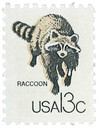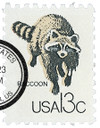
1978 13c Wildlife from Canadian/US Border,Raccoon
# 1757h - 1978 13c Wildlife from Canadian/US Border - Raccoon
$0.50 - $3.20
U.S. #1757h
1978 13¢ CAPEX Wildlife
Issue Date: June 10, 1978
City: Toronto, Canada
Quantity: 15,170,400
Quantity: 15,170,400
Printed By: Bureau of Engraving and Printing
Printing Method: Lithographed, engraved
Perforations: 11
Color: Multicolored
Issued in conjunction with the 1978 Canadian Philatelic Exhibition in Toronto, the CAPEX souvenir sheet was the first U.S. souvenir sheet to be released outside the country. Eight different stamps, featuring popular animals and birds from North America, appear together on this colorful sheet.
The raccoon is easily recognized by the “mask” of black hair around its eyes, and its bushy ringed tail. American Indians and early settlers used to hunt this animal for fur, and the pelts were also used as money before paper currency was established.
U.S. #1757h
1978 13¢ CAPEX Wildlife
Issue Date: June 10, 1978
City: Toronto, Canada
Quantity: 15,170,400
Quantity: 15,170,400
Printed By: Bureau of Engraving and Printing
Printing Method: Lithographed, engraved
Perforations: 11
Color: Multicolored
Issued in conjunction with the 1978 Canadian Philatelic Exhibition in Toronto, the CAPEX souvenir sheet was the first U.S. souvenir sheet to be released outside the country. Eight different stamps, featuring popular animals and birds from North America, appear together on this colorful sheet.
The raccoon is easily recognized by the “mask” of black hair around its eyes, and its bushy ringed tail. American Indians and early settlers used to hunt this animal for fur, and the pelts were also used as money before paper currency was established.











